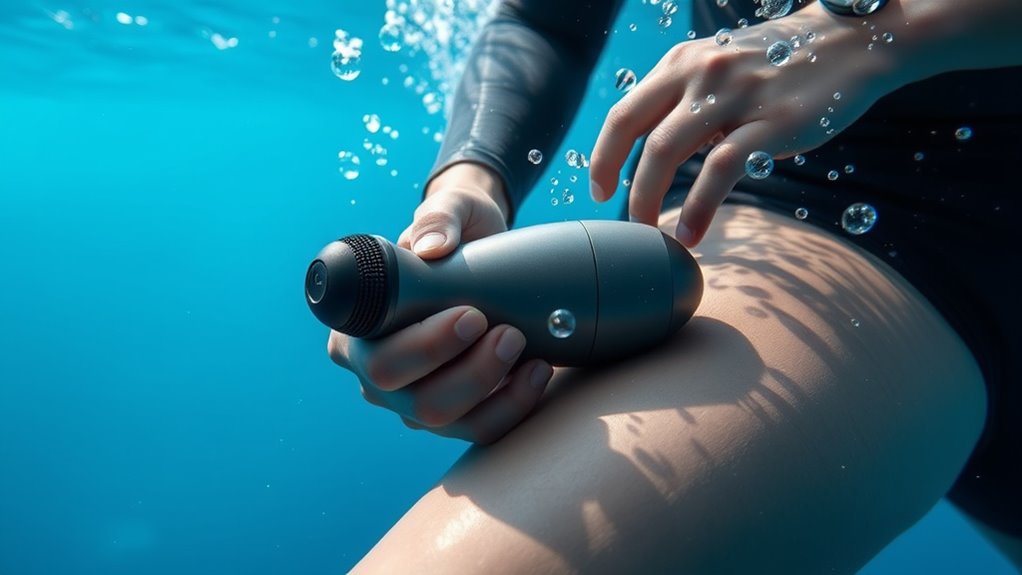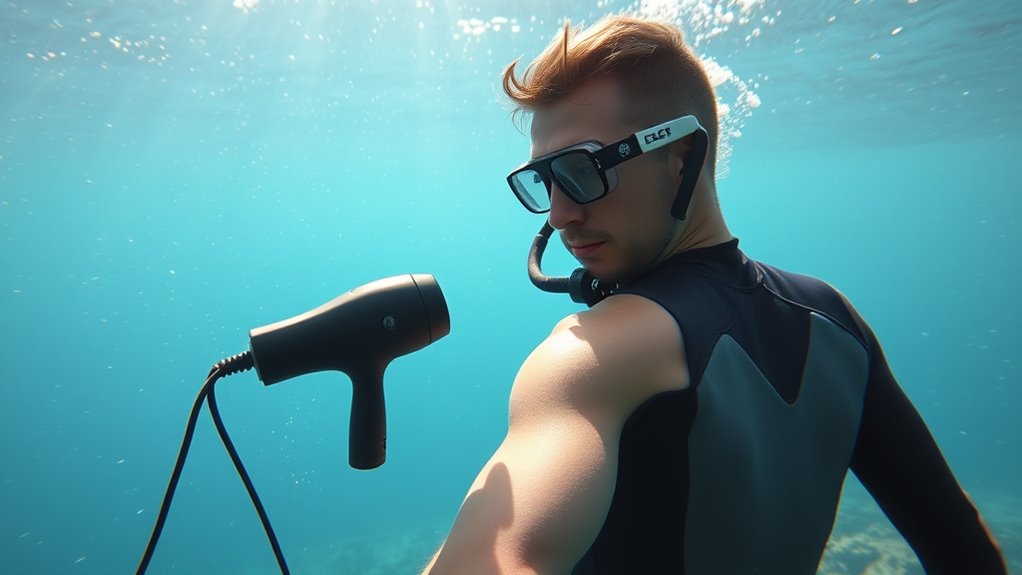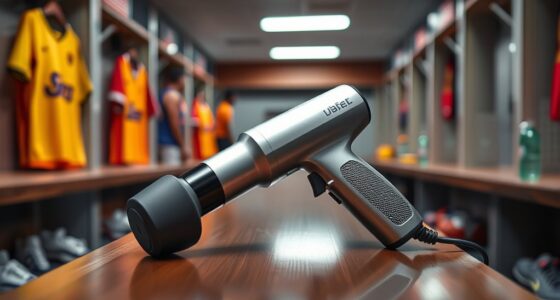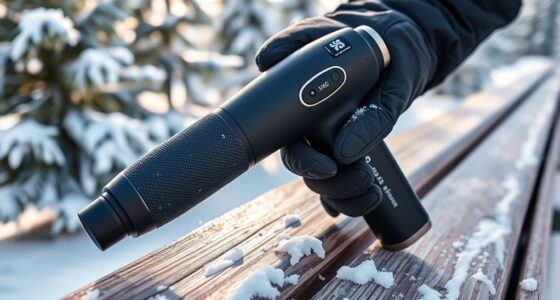Percussion therapy helps you prevent muscle stiffness underwater by boosting circulation and reducing tightness before and after dives. It uses rapid, targeted pulses to loosen muscles and break down knots, improving flexibility and reducing soreness. Regular use keeps your muscles well-conditioned, which enhances your comfort and performance underwater. If you keep exploring, you’ll discover how integrating this technique into your routine can make your dives safer and more enjoyable.
Key Takeaways
- Percussion therapy enhances blood flow and muscle flexibility, reducing stiffness before and after dives.
- Regular use prevents muscle tightness, minimizing the risk of cramps and injuries underwater.
- Portable percussion devices allow divers to target specific muscle groups easily during surface intervals.
- Incorporating therapy into routines maintains muscle health, ensuring better movement and equipment handling underwater.
- Preventing muscle stiffness improves endurance, safety, and overall diving performance.

If you’re a diver looking to optimize recovery and reduce muscle soreness, percussion therapy offers a promising solution. Underwater, your muscles endure intense exertion, and recovery becomes essential to maintaining performance and avoiding stiffness. Percussion therapy uses rapid, targeted pulses to stimulate blood flow, loosen tight muscles, and accelerate muscle recovery. By integrating this therapy into your routine, you can minimize downtime between dives and stay prepared for your next adventure. It’s especially effective because it reaches deep tissue layers, helping break down knots and lactic acid buildup that can cause prolonged soreness. This not only keeps muscles flexible but also reduces the risk of injuries caused by tightness.
Aside from enhancing muscle recovery, percussion therapy plays a significant role in equipment maintenance. When your muscles are well-conditioned and less stiff, you can perform routine checks and adjustments more efficiently. Tight or sore muscles can hinder your ability to handle your gear properly, increasing the chance of mistakes or accidents underwater. Regular use of percussion therapy ensures your muscles stay limber, making your movements smoother and more precise. This, in turn, helps you maintain your equipment more effectively, ensuring that everything functions as it should and reducing the likelihood of equipment failure during dives. Plus, by incorporating therapy sessions into your pre-dive or post-dive routines, you can better identify any areas of tension that might indicate overuse or strain, allowing for prompt intervention and reducing long-term wear.
Using percussion therapy also supports your overall maintenance routine by helping you stay aware of your body’s condition. When muscles are relaxed and healthy, you’re less likely to develop imbalances that could impair your diving technique or lead to injury. This proactive approach keeps you on top of potential issues before they escalate, ensuring your dives remain safe and enjoyable. Additionally, modern percussion devices are portable and easy to use, making them ideal for divers who want to incorporate therapy sessions into their busy schedules. Whether at the surface or in between dives, you can target specific muscle groups to keep them in prime condition. Regular use can also prevent muscle stiffness and improve your overall flexibility and endurance for diving.
Frequently Asked Questions
Can Percussion Therapy Be Safely Used During a Dive?
You might wonder if percussion therapy can be safely used during a dive. Generally, it’s not recommended because equipment safety and therapy timing are essential. Using percussion devices underwater can interfere with diving gear and pose safety risks. It’s best to perform any therapy before or after your dive. Always consult a medical professional or dive safety expert to make sure your health and equipment are protected during your diving activities.
How Often Should Divers Use Percussion Therapy Pre- or Post-Dive?
You should use percussion therapy thoughtfully to support muscle recovery and enhance dive safety. Typically, applying it post-dive helps reduce muscle stiffness and promotes quicker recovery, so doing it 1-2 times a week is sufficient. Avoid overuse before diving, as it might cause fatigue. Always listen to your body, and consult a professional if you’re unsure, to ensure safe and effective muscle recovery without compromising dive safety.
Are There Any Contraindications for Percussion Therapy Underwater?
Like a cautious sailor steering surface water, you should be aware of contraindications for percussion therapy underwater. You may face risks if you have open wounds, infections, or skin conditions that could worsen with water exposure. Always make certain your equipment is safe and properly sanitized to prevent infections. If you’re pregnant or have certain health issues, consult a medical professional. Safety first—know your limits before using percussion therapy underwater.
What Equipment Is Necessary for Percussion Therapy Underwater?
To perform an underwater massage, you’ll need specialized percussion therapy equipment designed for water use, guaranteeing it’s waterproof and safe underwater. You might also use your standard dive equipment like wetsuits and fins to access different muscle areas comfortably. Always ensure the device is compatible with underwater conditions and that you follow safety guidelines. Proper equipment helps you deliver effective percussion therapy, preventing muscle stiffness during your dive.
How Does Percussion Therapy Compare to Traditional Stretching for Divers?
You’ll find percussion therapy often offers quicker muscle relaxation compared to traditional stretching. It targets deep tissues, reducing stiffness and improving blood flow, which helps prevent injuries. While stretching is effective, percussion therapy can be more efficient, especially underwater where movement is limited. You get faster recovery, better flexibility, and enhanced injury prevention, making it a valuable addition to your dive preparation and recovery routine.
Conclusion
As you dive deeper into percussion therapy, you realize it’s more than just muscle relief—it’s a safeguard against underwater stiffness. While the ocean’s vastness offers freedom, muscle tension can quickly shackle you. By embracing percussion therapy, you strike a balance between the weightlessness of the dive and the strength needed to return. In this dance between relaxation and resilience, you find that prevention becomes your greatest ally beneath the waves.









